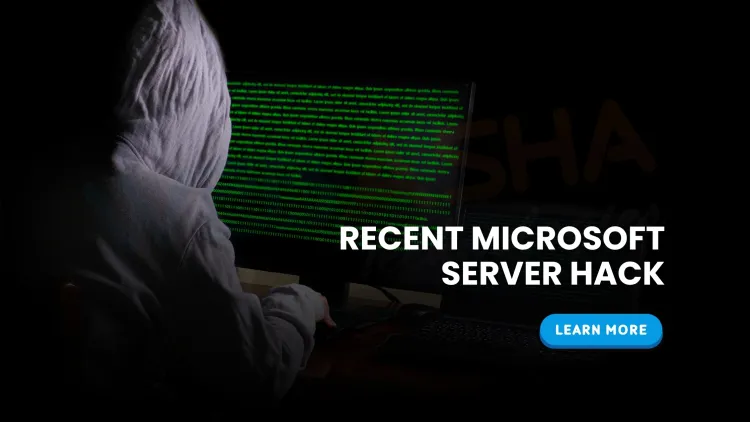What was the recent Microsoft server hack and how did it affect global organizations?
A major cyberattack exploited a zero-day vulnerability in Microsoft SharePoint servers, affecting nearly 100 organizations worldwide. The breach allowed attackers—possibly state-sponsored—to insert backdoors into self-managed servers used by government agencies, banks, healthcare, and industrial entities. The attack highlights the critical need for immediate patching, system hardening, and proactive cyber defense across organizations of all sizes.

Table of Contents
- What Happened in the Microsoft Server Hack?
- What Is the Vulnerability in Microsoft SharePoint?
- Who Are the Affected Victims?
- Who Discovered the Attack?
- How Are Cybersecurity Experts Responding?
- Is This Linked to Nation-State Espionage?
- Impact of the Hack and What It Reveals
- Steps Organizations Must Take Now
- Conclusion
- Frequently Asked Questions (FAQs)
What Happened in the Microsoft Server Hack?
In one of the most widespread cyber espionage campaigns of 2025, a major vulnerability in Microsoft SharePoint servers has allowed hackers to compromise nearly 100 organizations worldwide. According to researchers from Eye Security and ShadowServer Foundation, the zero-day vulnerability enabled threat actors to insert backdoors into self-managed SharePoint systems used by governments and enterprises alike.
Microsoft confirmed the breach over the weekend and issued a security alert urging urgent patching of the vulnerability. The FBI, UK's National Cyber Security Centre (NCSC), and other cybersecurity bodies are actively investigating the attacks, with suspicions pointing toward a state-sponsored group, possibly linked to China.

What Is the Vulnerability in Microsoft SharePoint?
The breach centers around a zero-day vulnerability—a flaw unknown to Microsoft before being exploited. Attackers used this flaw to:
-
Penetrate self-managed SharePoint servers
-
Install persistent backdoors
-
Maintain long-term unauthorized access
These backdoors give hackers covert control, allowing data exfiltration, surveillance, and potential sabotage.
Who Are the Affected Victims?
While no specific organization names have been publicly released, the breached targets reportedly include:
-
Government agencies
-
Financial institutions
-
Healthcare systems
-
Auditing firms
-
Industrial companies
-
State-level U.S. entities and global firms
According to internet scan data via Shodan, over 8,000 servers may still be vulnerable, many of which are high-value targets with sensitive data.
Who Discovered the Attack?
The breach was first detected on Friday, July 19, 2025, by cybersecurity firm Eye Security, based in the Netherlands. Chief hacker Vaisha Bernard identified unusual activity on a client’s network, which led to a broader investigation by the ShadowServer Foundation. Their scanning uncovered approximately 100 infected organizations globally.
How Are Cybersecurity Experts Responding?
Microsoft’s Response:
-
Issued urgent patches and guidance
-
Alerted users on active exploitation of the SharePoint vulnerability
-
Recommends all self-managed users update immediately
FBI and Global Cyber Agencies:
-
Confirmed awareness of the breach
-
Working in collaboration with Microsoft and private partners
-
Actively investigating attribution and wider impact
Cybersecurity Community:
-
Experts recommend assuming compromise for unpatched systems
-
Applying patches is necessary but not sufficient
-
Recommend forensic audits, network segmentation, and threat hunting
Is This Linked to Nation-State Espionage?
Although attribution remains unofficial, researchers and Google security analysts suggest this campaign may be linked to Chinese state-sponsored hackers. The scale, sophistication, and timing of the attack resemble tactics seen in recent state-backed cyber espionage activities targeting Western infrastructure.
Impact of the Hack and What It Reveals
This breach reveals:
-
The fragility of unpatched systems
-
The importance of proactive monitoring
-
The danger of assuming security through obscurity
For businesses and governments, the attack serves as a wake-up call. Even widely trusted platforms like SharePoint, when self-hosted, can become critical weaknesses if not properly maintained.
Steps Organizations Must Take Now
| Action | Description |
|---|---|
| Patch Immediately | Install Microsoft’s latest SharePoint updates without delay |
| Conduct Compromise Assessments | Analyze logs, detect anomalies, and hunt for known indicators of compromise |
| Segment Networks | Limit exposure and contain lateral movement |
| Review Access Logs | Check for unauthorized login attempts or backdoor creation |
| Update Incident Response Plans | Align response capabilities with the latest threat intelligence |
Conclusion
This incident underscores how one overlooked vulnerability can lead to large-scale global consequences. The Microsoft SharePoint hack is not just a technical failure—it’s a strategic cybersecurity event with implications for national security, business continuity, and global cyber hygiene.
With over 100 known victims—and possibly thousands more exposed—the message is clear: patch fast, monitor continuously, and never assume you’re safe.
FAQ
What is the Microsoft SharePoint server hack about?
A zero-day vulnerability was exploited in Microsoft SharePoint servers, allowing attackers to gain unauthorized access to systems.
When did the Microsoft server hack happen?
The attack was detected around July 19, 2025, and made public by Microsoft on July 20.
Who discovered the Microsoft SharePoint breach?
The breach was discovered by Eye Security and confirmed through scans by ShadowServer Foundation.
How many organizations were affected in the Microsoft breach?
Approximately 100 organizations have been confirmed as victims so far.
What kind of organizations were targeted?
Government agencies, banks, healthcare institutions, auditors, and industrial firms were among the targets.
What is a zero-day vulnerability?
A zero-day vulnerability is a software flaw unknown to the vendor that hackers exploit before it can be patched.
Did Microsoft release a patch for the vulnerability?
Yes, Microsoft has issued a security update for the exploited vulnerability.
Is the FBI investigating the Microsoft server hack?
Yes, the FBI is working with partners to investigate the breach.
Could this attack be linked to China?
While attribution is not official, researchers and Google have indicated possible links to China.
What is Eye Security?
Eye Security is a Dutch cybersecurity firm that discovered the initial signs of this breach.
What is ShadowServer Foundation?
It’s a cybersecurity nonprofit that helps identify global internet threats via infrastructure scans.
What are backdoors in cyberattacks?
Backdoors are hidden access points that allow persistent unauthorized access to systems.
How did hackers exploit the SharePoint servers?
By targeting unpatched, self-managed SharePoint servers with a newly discovered vulnerability.
Are cloud-hosted SharePoint services also affected?
No, the attack appears limited to self-hosted (on-premises) SharePoint installations.
How many servers remain vulnerable?
Over 8,000 servers globally may still be vulnerable, according to Shodan data.
Is patching the server enough to stay safe?
No, additional measures like threat hunting and forensic analysis are also recommended.
What should affected organizations do?
Immediately patch systems, conduct compromise assessments, and implement stronger monitoring.
What role did Microsoft play in resolving the breach?
Microsoft issued patches, alerts, and guidance on mitigating the vulnerability.
Is this Microsoft hack part of a larger espionage campaign?
Researchers believe this breach may be part of a broader cyber espionage operation.
Has any data been confirmed as stolen?
There is no official confirmation yet, but unauthorized access and potential data theft are likely.
What countries are affected by the hack?
Organizations in the U.S., UK, and other international entities have been impacted.
How are cybersecurity firms responding?
Firms are warning of widespread compromise and advising urgent threat assessments.
What can businesses do to prevent similar attacks?
Keep systems updated, use threat detection tools, and implement zero-trust architecture.
What is the impact on Microsoft’s reputation?
This breach underscores persistent challenges with securing enterprise infrastructure.
Should all SharePoint users be concerned?
Yes, especially those running self-managed or outdated installations.
How does a SharePoint exploit affect business operations?
It can lead to data loss, service disruption, and legal/regulatory consequences.
What is an assumed breach approach?
It means operating with the mindset that a system is already compromised and acting accordingly.
Are there signs of the attack spreading?
Security researchers warn that more actors may begin exploiting the same vulnerability.
How can I check if my server is affected?
Use security scanning tools or consult with cybersecurity experts for a full assessment.
What is the future risk after this Microsoft hack?
The breach may inspire copycat attacks and increase exploitation of enterprise software globally.














![Top 10 Ethical Hackers in the World [2025]](https://www.webasha.com/blog/uploads/images/202408/image_100x75_66c2f983c207b.webp)








